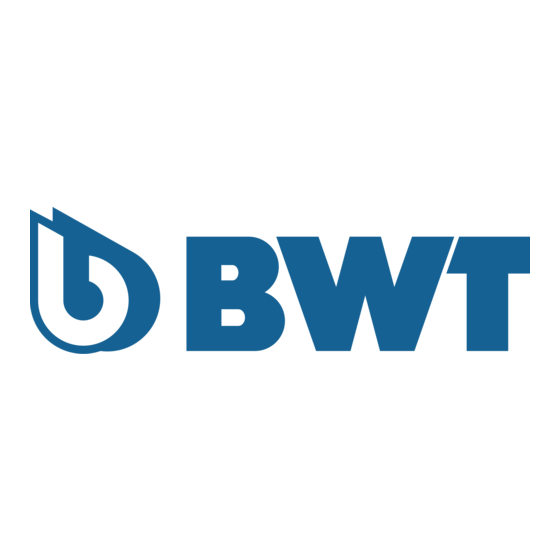
Advertisement
Installation, Commissioning,
Programming & User Information
For Water Softener Models:
SF 10 Litre Timed & SF 12 Litre Metered
These instructions are designed to give you the customer a complete understanding of how to locate, install, programme and
obtain trouble-free running of your water softener.
Whether you intend to install the unit yourself or obtain the services of a tradesman, please spend a few minutes reading through
this booklet and the other enclosed details. It will give you a complete understanding of the "SOFT WATER WORLD" that you are
about to enter. PLEASE RETAIN FOR FUTURE REFERENCE.
FIG. 1
Softened
water
By-pass valve
shown closed
Non-return
check valve
Hard water
to
drinking
and/or outside
garden tap
Incoming rising
main (Hard water)
LOCATION
The water softener should be located as close as practicable to the incoming cold rising main supply. Very often (but not always)
this main is in the kitchen or utility room. Sometimes the main rises in a downstairs cloakroom, under the stairs, or in the
garage. In most cases the softener can be sited in any of these locations as well as outside (with a suitable frost protection
cabinet) or even in the loft space.
If you are planning to install the water softener above ground level, e.g. in the loft, the following instructions should be strictly
adhered to. The water softener should be installed within a container of not less than 113.65 Litres (25 gallons) capacity, to
which there shall be connected an overflow pipe not less than 19mm (3/4 inch) in diameter. The overflow shall be connected not
less than 152.4 mm (six inches) below the height of any electrical components mounted on the softener. Where necessary the
water softener and any additional pipework should be adequately lagged to prevent damage by freezing.
Requirements for Installation of the Water Softener.
Mains Water Supply 25-70 p.s.i. (1.75-5 Bar) pressure.
A waste and overflow connection.
ON
OFF
Pipework sized to suit
installation requirements
(flexible hoses are provided
for your convenience)
Outlet valve
shown open
Inlet valve
shown open
Bend to
Outside
Pressure limiting
valve (if required)
Existing stop-cock
•
Optimum pressure is 60 p.s.i. (4 Bar).
•
•
An electrical point.
OUT
IN
Drain
hose
Overflow
Brine Cabinet
Access for salt filling and service.
October 2003 Part# SFINST
Fixing clip
Air gap
Hidden
Detail
Existing or
new "Trapped"
Stand Pipe or to
External Gully
Advertisement
Table of Contents

Summary of Contents for BWT SF 10 Litre Timed
- Page 1 Programming & User Information For Water Softener Models: SF 10 Litre Timed & SF 12 Litre Metered October 2003 Part# SFINST These instructions are designed to give you the customer a complete understanding of how to locate, install, programme and obtain trouble-free running of your water softener.
-
Page 2: Pre-Installation
Ensure the “drain off cock” is closed and turn back on the existing stopcock. This will allow hard water to again enter the system. CONNECTING INLET/OUTLET HOSES MODEL SF 10 Litre Timed FIG. 2 Fit the two ⁄... - Page 3 POWER FAILURES In the event of an electrical power failure it will be necessary to reset the time displayed - see section 10 for water softener model “SF 10 Litre Timed”, for model “SF 12 Litre Metered” see section 13.
- Page 4 COMMISSIONING THE WATER SOFTENER For Model “SF Timed”, follow Sections 9,10 and 11. For other models, go straight to Sections 12. COMMISSIONING THE WATER SOFTENER – ALL MODELS It will be necessary to ascertain the hardness of your water. This information is available from your local water supply company. Alternatively hardness testing kits are available form Culligan or your supplier.
- Page 5 INSTALLATION (cont) DECIDING WHEN TO REGENERATE THE SF METERED SOFTENER Because the Softener works on a metering device, this allows it to decide the frequency of regeneration that best suits your needs. Simply program the incoming mains hardness and the softener will do the rest! COMMISSIONING THE SF METERED SOFTENER SET THE PROGRAMMER Obtain your water hardness from your local water authority, or alternatively purchase a Test Kit from your supplying retailer.
-
Page 6: Product Information
PRODUCT INFORMATION ELECTRICAL CONNECTION The softeners must be connected to an electrical supply. The consumption is only three watts which is used to drive the power unit. All other cycles on the valve are operated by water pressure. The Timer and Metered Softeners are low voltage for safety and is supplied with a plug in transformer. -
Page 7: Troubleshooting
TROUBLESHOOTING Before contacting your supplier or our service department, please complete the check list below. A service visit can very often be avoided by studying the information below or alternatively discussing the problem over the telephone. Always check your salt level at a regular (at least monthly) interval and top up as necessary. The technology upon which Culligan Water Softeners are based is well established and proven in service over many years. - Page 8 High Wycombe HP12 3SU United Kingdom Buckinghamshire. HP12 3SU Date Installed Tel: 01376 334 200 As part of the BWT policy of continuous improvement all specifications are subject to change without prior notice Fax: 01376 334 201 Regeneration Set Every Days...














Need help?
Do you have a question about the SF 10 Litre Timed and is the answer not in the manual?
Questions and answers